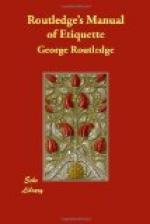In dancing the Polka, or any circular dance where a large number of couples are performing at the same time, the gentleman must be careful to steer his fair burden safely through the mazes of the crowded ball-room. A little watchfulness can almost always avoid collisions, and a good dancer would consider himself disgraced if any mishap occurred to a lady under his care. Keep a sharp look out, and avoid crowded corners. Should so many couples be dancing as to render such caution impossible, stop at once, and do not go on until the room has become somewhat cleared. In a few minutes others will have paused to rest, and you can then continue. Your partner will be grateful that your consideration has preserved her from the dismal plight in which we have seen some ladies emerge from this dance—their coiffeurs disordered, their dresses torn, and their cheeks crimson with fatigue and mortification, while their indignant glances plainly showed the anger they did not care to express in words, and which their reckless partner had fully deserved. A torn dress is sometimes not the heaviest penalty incurred: we have known more than one instance where ladies have been lamed for weeks through the culpable carelessness of their partners, their tender feet having been half crushed beneath some heavy boot in one of these awkward collisions. This is a severe price to pay for an evening’s amusement, and gentlemen are bound to be cautious how they inflict it, or anything approaching to it, upon their fair companions. Ladies, on the other hand, will do well to remember that by leaning heavily upon their partner’s shoulder, dragging back from his encircling arm or otherwise impeding the freedom of his movements, they materially add to his labour and take from his pleasure in the dance. They should endeavour to lean as lightly, and give as little trouble, as possible; for, however flattering to the vanity of the nobler sex may be the idea of feminine dependence, we question whether the reality, in the shape of a dead weight upon their aching arms throughout a Polka or Valse of twenty minutes’ duration, would be acceptable to even the most chivalrous amongst them.
We have been thus minute in our instructions, because they not only apply to the Polka, but equally to all circular dances where a great number stand up to dance at the same time.
We now pass on to the
* * * * *
X.—CELLARIUS VALSE.
Sometimes called the Mazourka, though generally best known by the name of its inventor, M. Cellarius, of Paris. It was imported to England in 1845, two years after the introduction of the Polka; and, although it never attained so great a popularity as its predecessor, it was favourably received, and much danced in the best circles. Still it failed to achieve the decided success which might have been reasonably expected from its elegance and beauty. Perhaps one reason of this disappointing result was that many inefficient




